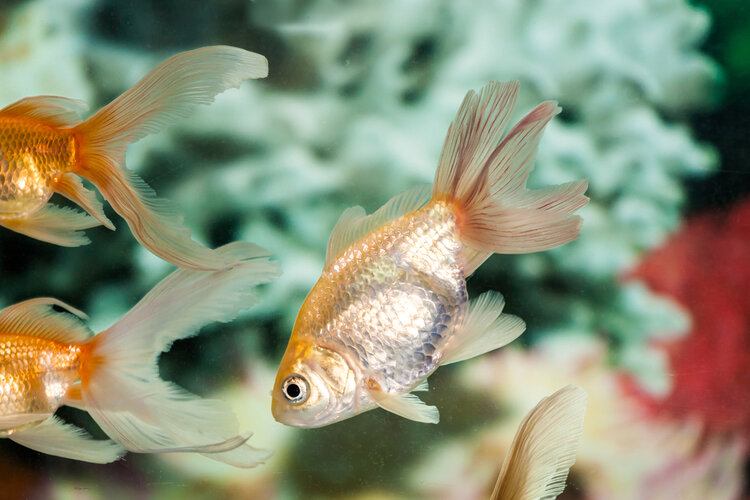Goldfish can turn white due to poor water quality or lack of adequate light exposure. Stress and aging can also cause color changes.
Goldfish are known for their vibrant colors, but sometimes they start turning white. This change can be alarming for pet owners who want to ensure their fish stay healthy. Poor water quality is a common cause, as it affects the fish’s overall well-being.
Lack of adequate light exposure can also lead to a loss of color. Stress, whether from overcrowding or sudden temperature changes, can be another factor. Aging naturally causes some goldfish to change color. Regular water testing, proper lighting, and a stress-free environment can help maintain your goldfish’s color and health.

Credit: www.reddit.com
The Phenomenon Of Color Change
Goldfish are known for their vibrant colors, but sometimes they turn white. This phenomenon can be surprising and concerning for pet owners. Understanding why this happens can help you better care for your goldfish.
Natural Pigmentation Process
Goldfish get their color from pigments in their skin. These pigments are influenced by genetics, diet, and light exposure. A goldfish’s color can change due to these factors.
One common reason for color change is a lack of sunlight. Goldfish need light to maintain their colors. Without enough light, their pigments can fade.
Diet also plays a role. Goldfish need a balanced diet with specific nutrients. If their diet lacks these nutrients, their colors can fade.
Signs Of Color Transformation
Noticing your goldfish turning white? Pay attention to certain signs. These signs can help you determine the cause.
| Sign | Possible Cause |
|---|---|
| Gradual whitening | Lack of light or nutrients |
| Patchy color loss | Health issues or stress |
| Sudden color change | Water quality or temperature changes |
Observe your goldfish closely. A gradual whitening could mean they’re not getting enough light or nutrients. Patchy color loss might indicate health issues or stress. Sudden changes could be due to water quality or temperature changes.
Keeping a watchful eye can help you address the issue quickly. Ensure your goldfish has a proper diet and environment to maintain their vibrant colors.
Genetic Factors At Play
Understanding why your goldfish is turning white can be challenging. One common reason is genetic factors. These factors influence the color and patterns of your goldfish. Let’s explore this further by looking at inherited color variations and age-related changes.
Inherited Color Variations
Goldfish have a wide range of colors due to their genetics. Some fish may change color as they grow. This is often seen in goldfish that are bred for specific colors. The genes they inherit from their parents play a big role. If the parents had color changes, the offspring might too.
A table can help understand these variations better:
| Color | Genetic Influence |
|---|---|
| Orange | Common in many goldfish breeds |
| White | Can appear with age or stress |
| Black | Less common, often seen in specific breeds |
Age-related Changes
Age can also cause color changes in goldfish. As goldfish grow older, their color may fade. This is a natural process influenced by their genetic makeup. Young goldfish often have brighter colors. These colors can become duller as they age.
Here are some key points about age-related color changes:
- Young goldfish are usually more vibrant.
- Older goldfish may turn white or pale.
- Color changes can also indicate health issues.
Understanding these genetic factors helps in caring for your goldfish. Keep an eye on their color and overall health to ensure they are happy and thriving.
Health And Environmental Influences
Goldfish changing color is often influenced by their health and environment. Understanding these factors helps maintain their vibrant hue. Below, we explore some key health and environmental influences.
Stress-induced Color Shifts
Stress can cause goldfish to lose their bright colors. Common stressors include:
- Overcrowded tanks
- Inadequate nutrition
- Sudden changes in water temperature
- Improper handling
To reduce stress, ensure your goldfish has a spacious tank. Feed them a balanced diet and maintain a consistent water temperature. Handle your goldfish gently and avoid sudden movements.
Impact Of Water Conditions
Water quality greatly affects goldfish color. Poor water conditions can lead to color fading. Key factors to monitor include:
| Water Condition | Optimal Level |
|---|---|
| pH Level | 6.5 – 7.5 |
| Ammonia | 0 ppm |
| Nitrites | 0 ppm |
| Nitrates | Below 20 ppm |
Regularly test your water to maintain these levels. Use a quality water conditioner and filtration system. Clean the tank frequently to prevent harmful buildup.

Credit: www.hepper.com
Nutritional Contributions
Goldfish turning white can often be linked to their diet. Understanding how nutrition affects their color is key. Let’s explore the role of diet in maintaining your goldfish’s vibrant hue.
Dietary Deficiencies And Color
Goldfish need a balanced diet to maintain their color. A lack of essential nutrients can cause them to lose their vibrant hue.
Feeding your goldfish only flakes or pellets can lead to deficiencies. This can result in a noticeable color change.
Role Of Specific Nutrients
Certain nutrients are crucial for maintaining your goldfish’s color. Here are some key nutrients:
- Carotenoids: These pigments are found in foods like carrots and spinach. They help enhance the red, orange, and yellow colors.
- Protein: High-quality protein is essential for overall health and vibrant color.
- Vitamins: Vitamins A, C, and E are important. They support skin health and color retention.
Ensuring a varied diet can help provide these nutrients. Consider adding live or frozen foods like brine shrimp or daphnia.
Here’s a quick table summarizing key nutrients and their sources:
| Nutrient | Source | Benefits |
|---|---|---|
| Carotenoids | Carrots, Spinach | Enhances red, orange, yellow colors |
| Protein | High-quality fish food | Overall health and color |
| Vitamins A, C, E | Fresh vegetables, Fruits | Supports skin health |
Disease And Illness
Sometimes, goldfish turning white can indicate disease and illness. It’s important to monitor your goldfish for other symptoms. This can help in diagnosing the problem early.
Common Goldfish Ailments
Goldfish can suffer from various diseases and illnesses. Here are some common ones:
- Ichthyophthirius multifiliis (Ich): Small white spots on the skin and fins.
- Fin Rot: Frayed or discolored fins.
- Swim Bladder Disease: Difficulty swimming or floating.
- Fungal Infections: White, cotton-like growths on the body.
Symptoms Beyond Color Loss
Color loss is often a sign of stress or illness in goldfish. Here are other symptoms to watch for:
| Symptom | Description |
|---|---|
| Clamped Fins | Fins held close to the body. |
| Loss of Appetite | Goldfish stops eating or eats less. |
| Labored Breathing | Gasping at the surface or rapid gill movement. |
| Red Streaks | Red lines in fins or on the body. |
If you see these symptoms, check water quality and consult a vet.
Sunlight And Lighting Conditions
Understanding why your goldfish is turning white can be challenging. One key factor is sunlight and lighting conditions. Proper lighting is essential for your goldfish’s health and color.
Effect Of Light Exposure
Goldfish need a balance of light and darkness. Too much sunlight can cause them to lose color. Direct sunlight can also lead to algae growth in the tank. Algae can affect the water quality and stress your goldfish.
On the other hand, too little light can dull your goldfish’s color. Goldfish require a regulated light schedule. Around 8-12 hours of light per day is ideal. Consistent lighting helps maintain their vibrant colors.
Appropriate Aquarium Lighting
Choosing the right lighting for your aquarium is crucial. Using an aquarium light with a timer can help maintain a regular light cycle. LED lights are a good option as they are energy-efficient and produce less heat.
Make sure the light is not too bright. Excessive brightness can stress the fish. Place the aquarium away from direct sunlight. This prevents overexposure and keeps the water temperature stable.
Consider using a light spectrum that mimics natural sunlight. This helps in enhancing the natural colors of your goldfish. You can find lights specifically designed for aquariums at pet stores.
| Lighting Condition | Effect on Goldfish |
|---|---|
| Direct Sunlight | Color loss and algae growth |
| Too Little Light | Duller colors |
| Balanced Light | Maintains vibrant colors |
Remember to monitor the light and make adjustments as needed. By providing appropriate lighting, you help keep your goldfish healthy and colorful.
The Molting Misconception
Goldfish owners often notice color changes in their pets. One common concern is goldfish turning white. Many think this is due to molting. But, goldfish do not molt. Let’s explore this misconception.
Debunking Myths
Goldfish do not shed their scales like reptiles. The idea of goldfish molting is a myth. Instead, other factors cause their color to change. These can be environmental, genetic, or health-related. Understanding these factors helps in better goldfish care.
Understanding Goldfish Growth
Goldfish grow and change throughout their lives. Their color can fade or change due to:
- Water Quality: Poor water conditions can stress goldfish, affecting their color.
- Diet: A lack of certain nutrients can cause fading.
- Lighting: Less light can lead to a paler color.
Ensuring clean water, a balanced diet, and proper lighting can maintain their vibrant colors. Monitoring these aspects will help keep your goldfish healthy and colorful.
Preventive Measures And Care
Goldfish turning white can be alarming. Proper care and preventive measures help maintain their vibrant colors. This section will guide you through essential steps to keep your goldfish healthy and colorful.
Maintaining Optimal Conditions
Goldfish thrive in specific conditions. Keep their tank clean and well-maintained. Regularly change 20% of the water weekly. Ensure the water temperature is between 68°F and 74°F (20°C to 23°C).
Use a high-quality water filter. It helps remove harmful substances. Check the water’s pH level. It should be between 6.5 and 7.5. Consistent water quality is crucial for goldfish health.
| Parameter | Optimal Range |
|---|---|
| Temperature | 68°F – 74°F (20°C – 23°C) |
| pH Level | 6.5 – 7.5 |
| Water Change | 20% weekly |
Monitoring Fish Health
Regularly observe your goldfish. Look for changes in color or behavior. Check for signs of illness. This includes lethargy, loss of appetite, or spots on their body.
Feed your goldfish a balanced diet. Include high-quality flakes or pellets. Supplement with fresh vegetables like peas and spinach. A varied diet helps maintain their color.
- Check for color changes
- Observe behavior
- Monitor for illness signs
- Provide a balanced diet
Stress can cause color changes in goldfish. Keep their environment calm. Avoid sudden changes in water conditions. Ensure they have enough space to swim.
Following these steps ensures your goldfish remain healthy and vibrant. Consistent care and attention are key.

Credit: www.reddit.com
Conclusion
Understanding why your goldfish is turning white helps maintain its health. Regular tank maintenance and proper diet are essential. Monitor water quality and temperature closely. Seek advice from a vet if needed. Ensuring a healthy environment can prevent color changes.
Keep your goldfish vibrant and healthy by following these simple guidelines.
